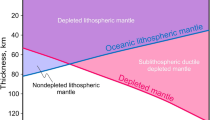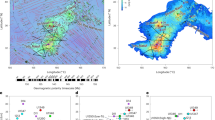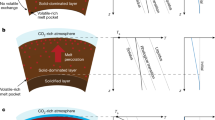Abstract
Liquid surface oceans are a seemingly unique feature of Earth. Long-term, global sea level depends on the balance of water fluxes between Earth’s mantle and surface: between mantle degassing through volcanism and mantle regassing via the subduction of hydrous minerals. However, the overall balance of these fluxes at geological timescales remains uncertain. Geological observations suggest the stability of the long-term sea level and thus a near-steady-state regassing–degassing balance. In contrast, according to current thermopetrological modelling, the global input of H2O inferred from geophysical observations leads to an unequivocal excess of regassing relative to degassing. Here we use recent experimental high-pressure data on natural hydrated peridotites to update the thermopetrological models and to reassess the calculations of H2O fluxes into the mantle via subduction. Our models of 56 subduction transects show that a global input of 15−20 × 108 TgH2O every million years yields a limited global mantle regassing of 2.0−3.5 × 108 TgH2O every million years. The regassing occurs exclusively via the hydrated lithospheric mantle of the coldest subducting plates. Our requantification of the H2O budget associated with subduction matches the estimations of mantle degassing and suggests that global sea levels have been relatively stable over geological timescales.
This is a preview of subscription content, access via your institution
Access options
Access Nature and 54 other Nature Portfolio journals
Get Nature+, our best-value online-access subscription
$29.99 / 30 days
cancel any time
Subscribe to this journal
Receive 12 print issues and online access
$259.00 per year
only $21.58 per issue
Buy this article
- Purchase on Springer Link
- Instant access to full article PDF
Prices may be subject to local taxes which are calculated during checkout




Similar content being viewed by others
Data availability
The numerical data generated for the 56 subduction transects (geotherms and water retention within the subducting slabs) are available in the Zenodo public repository https://doi.org/10.5281/zenodo.4632975.
Code availability
The code TerraFERMA used to compute the thermal models is open source and available at http://terraferma.github.io/. The thermodynamic code Perple_X is freely available at http://www.perplex.ethz.ch/ and information to reproduce the results is provided in Methods and the Supplementary Information.
References
Hirth, G. & Kohlstedf, D. Rheology of the upper mantle and the mantle wedge: a view from the experimentalists. Geophys. Monogr. 138, 83–106 (2003).
Regenauer-Lieb, K., Yuen, D. A. & Branlund, J. The initiation of subduction: criticality by addition of water? Science 294, 578–580 (2001).
Kasting, J. F. & Catling, D. Evolution of a habitable planet. Annu. Rev. Astron. Astrophys. 41, 429–463 (2003).
Conrad, C. P. The solid Earth’s influence on sea level. Bulletin 125, 1027–1052 (2013).
van Keken, P. E., Hacker, B. R., Syracuse, E. M. & Abers G. A, Subduction factory: 4. Depth‐dependent flux of H2O from subducting slabs worldwide. J. Geophys. Res. Solid Earth https://doi.org/10.1029/2010JB007922 (2011).
Parai, R. I. T. A. & Mukhopadhyay, S. U. J. O. Y. How large is the subducted water flux? New constraints on mantle regassing rates. Earth Planet. Sci. Lett. 317, 396–406 (2012).
Hirschmann, M. M. Comparative deep Earth volatile cycles: the case for C recycling from exosphere/mantle fractionation of major (H2O, C, N) volatiles and from H2O/Ce, CO2/Ba, and CO2/Nb exosphere ratios. Earth Planet. Sci. Lett. 502, 262–273 (2018).
Vail, P. R., Mitchum R. M. Jr & Thompson, S. III in Seismic Stratigraphy—Applications to Hydrocarbon Exploration (ed. Payton, C. E.) 83–98 (American Association of Petroleum Geologists Memoir 26, 1977).
Hallam, A. Phanerozoic Sea-Level Changes (Columbia Univ. Press, 1992).
Haq, B. U. & Schutter, S. R. A chronology of Paleozoic sea-level changes. Science 322, 64–68 (2008).
Karlsen, K. S., Conrad, C. P. & Magni, V. Deep water cycling and sea level change since the breakup of Pangea. Geochem. Geophys. Geosyst. 20, 2919–2935 (2019).
Rüpke, L. H., Morgan, J. P., Hort, M. & Connolly, J. A. Serpentine and the subduction zone water cycle. Earth Planet. Sci. Lett. 223, 17–34 (2004).
Faccenda, M., Gerya, T. V. & Burlini, L. Deep slab hydration induced by bending-related variations in tectonic pressure. Nat. Geosci. 2, 790–793 (2009).
Magni, V., Bouilhol, P. & van Hunen, J. Deep water recycling through time. Geochem. Geophys. Geosyst. 15, 4203–4216 (2014).
Wallace, P. J. Volatiles in subduction zone magmas: concentrations and fluxes based on melt inclusion and volcanic gas data. J. Volcanol. Geotherm. Res. 140, 217–240 (2005).
Ranero, C. R., Morgan, J. P., McIntosh, K. & Reichert, C. Bending-related faulting and mantle serpentinization at the Middle America trench. Nature 425, 367–373 (2003).
Contreras‐Reyes, E., Grevemeyer, I., Flueh, E. R. & Reichert, C. Upper lithospheric structure of the subduction zone offshore of southern Arauco peninsula, Chile, at ∼38 °S. J. Geophys. Res. Solid Earth https://doi.org/10.1029/2007JB005569 (2008).
Emry, E. L. & Wiens, D. A. Incoming plate faulting in the Northern and Western Pacific and implications for subduction zone water budgets. Earth Planet. Sci. Lett. 414, 176–186 (2015).
Cai, C., Wiens, D. A., Shen, W. & Eimer, M. Water input into the Mariana subduction zone estimated from ocean-bottom seismic data. Nature 563, 389–392 (2018).
Hermann, J. & Lakey, S. Water transfer to the deep mantle through hydrous, Al-rich silicates in subduction zones. Geology https://doi.org/10.1130/G48658.1 (2021).
Schmidt, M. W. & Poli, S. Experimentally based water budgets for dehydrating slabs and consequences for arc magma generation. Earth Planet. Sci. Lett. 163, 361–379 (1998).
Okamoto, K. & Maruyama, S. The high-pressure synthesis of lawsonite in the MORB + H2O system. Am. Mineral. 84, 362–373 (1999).
Iwamori, H. Phase relations of peridotites under H2O-saturated conditions and ability of subducting plates for transportation of H2O. Earth Planet. Sci. Lett. 227, 57–71 (2004).
Maurice, J. et al. The stability of hydrous phases beyond antigorite breakdown for a magnetite-bearing natural serpentinite between 6.5 and 11 GPa. Contrib. Mineral. Petrol. 173, 86 (2018).
Maurice, J. et al. The intrinsic nature of antigorite breakdown at 3 GPa: experimental constraints on redox conditions of serpentinite dehydration in subduction zones. Contrib. Mineral. Petrol. 175, 94 (2020).
Syracuse, E. M., van Keken, P. E. & Abers, G. A. The global range of subduction zone thermal models. Phys. Earth Planet. Inter. 183, 73–90 (2010).
Holland, T. J. B. & Powell, R. An improved and extended internally consistent thermodynamic dataset for phases of petrological interest, involving a new equation of state for solids. J. Metamorphic Geol. 29, 333–383 (2011).
Connolly, J. A. D. The geodynamic equation of state: what and how. Geochem. Geophys. Geosyst. https://doi.org/10.1029/2009GC002540 (2009).
Schmidt, M. & Poli, S. in Treatise on Geochemistry 2nd edn (eds Holland, H. D. & Turekian, K. K.) 669–701 (Elsevier, 2014).
Wada, I. & Wang, K. Common depth of slab‐mantle decoupling: reconciling diversity and uniformity of subduction zones. Geochem. Geophys. Geosyst. https://doi.org/10.1029/2009GC002570 (2009).
Arcay, D. Dynamics of interplate domain in subduction zones: influence of rheological parameters and subducting plate age. Solid Earth 3, 467–488 (2012).
Liu, L. G. Effects of H2O on the phase behaviour of the forsterite–enstatite system at high pressures and temperatures and implications for the Earth. Phys. Earth Planet. Inter. 49, 142–167 (1987).
Ulmer, P. & Trommsdorff, V. Serpentine stability to mantle depths and subduction-related magmatism. Science 268, 858–861 (1995).
Fumagalli, P. & Poli, S. Experimentally determined phase relations in hydrous peridotites to 6.5 GPa and their consequences on the dynamics of subduction zones. J. Petrol. 46, 555–578 (2005).
Dvir, O., Pettke, T., Fumagalli, P. & Kessel, R. Fluids in the peridotite–water system up to 6 GPa and 800 °C: new experimental constrains on dehydration reactions. Contrib. Mineral. Petrol. 161, 829–844 (2011).
Kawamoto, T., Hervig, R. L. & Holloway, J. R. Experimental evidence for a hydrous transition zone in the early Earth’s mantle. Earth Planet. Sci. Lett. 142, 587–592 (1996).
Komabayashi, T. & Omori, S. Internally consistent thermodynamic data set for dense hydrous magnesium silicates up to 35 GPa, 1600 °C: implications for water circulation in the Earth’s deep mantle. Phys. Earth Planet. Inter. 156, 89–107 (2006).
Hacker, B. R. H2O subduction beyond arcs. Geochem. Geophys. Geosyst. https://doi.org/10.1029/2007GC001707 (2008).
Buffett, B. A. & Heuret, A. Curvature of subducted lithosphere from earthquake locations in the Wadati–Benioff zone. Geochem. Geophys. Geosyst. https://doi.org/10.1029/2011GC003570 (2011).
Wilson, C. R., Spiegelman, M., van Keken, P. E. & Hacker, B. R. Fluid flow in subduction zones: the role of solid rheology and compaction pressure. Earth Planet. Sci. Lett. 401, 261–274 (2014).
Cerpa, N. G., Wada, I. & Wilson, C. R. Fluid migration in the mantle wedge: influence of mineral grain size and mantle compaction. J. Geophys. Res. Solid Earth 122, 6247–6268 (2017).
Mibe, K. et al. Second critical endpoint in the peridotite–H2O system. J. Geophys. Res. Solid Earth https://doi.org/10.1029/2005JB004125 (2007).
Padrón‐Navarta, J. A. & Hermann, J. A subsolidus olivine water solubility equation for the Earth’s upper mantle. J. Geophys. Res. Solid Earth 122, 9862–9880 (2017).
Omori, S., Komabayashi, T. & Maruyama, S. Dehydration and earthquakes in the subducting slab: empirical link in intermediate and deep seismic zones. Phys. Earth Planet. Inter. 146, 297–311 (2004).
Green, H. W. II, Chen, W. P. & Brudzinski, M. R. Seismic evidence of negligible water carried below 400-km depth in subducting lithosphere. Nature 467, 828–831 (2010).
Ferrand, T. P. Seismicity and mineral destabilizations in the subducting mantle up to 6 GPa, 200 km depth. Lithos 334, 205–230 (2019).
Smyth, J. R. et al. Structural systematics of hydrous ringwoodite and water in Earth’s interior. Am. Mineral. 88, 1402–1407 (2003).
Fei, H. & Katsura, T. High water solubility of ringwoodite at mantle transition zone temperature. Earth Planet. Sci. Lett. 531, 115987 (2020).
Houser, C. Global seismic data reveal little water in the mantle transition zone. Earth Planet. Sci. Lett. 448, 94–101 (2016).
Maunder, B., van Hunen, J., Bouilhol, P. & Magni, V. Modeling slab temperature: a reevaluation of the thermal parameter. Geochem. Geophys. Geosyst. 20, 673–687 (2019).
Wilson, C. R., Spiegelman, M. & van Keken, P. E. Terra FERMA: The Transparent Finite Element Rapid Model Assembler for multiphysics problems in Earth sciences. Geochem. Geophys. Geosyst. 18, 769–810 (2017).
Hayes, G. P. et al. Slab2, a comprehensive subduction zone geometry model. Science 362, 58–61 (2018).
Stein, C. A. & Stein, S. A model for the global variation in oceanic depth and heat flow with lithospheric age. Nature 359, 123–129 (1992).
Howe, H. & Pawley, A. R. The effect of solid solution on the stability of talc and 10-Å phase. Contrib. Mineral. Petrol. 174, 81 (2019).
Wada, I., Behn, M. D. & Shaw, A. M. Effects of heterogeneous hydration in the incoming plate, slab rehydration, and mantle wedge hydration on slab-derived H2O flux in subduction zones. Earth Planet. Sci. Lett. 353, 60–71 (2012).
Crameri, F. Scientific colour-maps. Zenodo https://zenodo.org/record/2649252#.YjHEzainyUk (2018).
Acknowledgements
We thank A. Tommasi and S. Lallemand for their very useful suggestions, and S. Arnal and F. Rétif for their assistance in installing the code on the clusters. This study was publicly funded by through ANR under the ‘Investissements d’avenir, Initiative Sciences Innovation Territoires—MUSE’ programme with reference ANR-16-IDEX-0006. The work was realized with the support of the HPC Platform MESO@LR, financed by the Occitanie/Pyrénées-Méditerranée Region, Montpellier Mediterranean Metropole and the University of Montpellier. J.A.P.-N. is supported by the project DESTINE (PID2019-105192GB-I00) funded by MICIN/AEI/10.13039/501100011033 and the FEDER programme ‘Una manera de hacer Europa’, and acknowledges a Ramón y Cajal contract (RYC2018-024363-I) funded by MICIN/AEI/10.13039/501100011033 and the FSE program ‘FSE invierte en tu futuro’. Perceptually uniform colour maps were used in some figures of this study to prevent visual distortion of the data56.
Author information
Authors and Affiliations
Contributions
N.G.C. conceived the study, designed and performed the numerical models, analysed the results and wrote the first draft of the paper. D.A. provided funding for the project, participated in conceiving the study and analysed the results. J.A.P.-N. contributed to the petrological modelling and to the analysis of the results. All the authors discussed the implications of the study and wrote the manuscript.
Corresponding author
Ethics declarations
Competing interests
The authors declare no competing interests.
Peer review
Peer review information
Nature Geoscience thanks Valentina Magni and the other, anonymous, reviewer(s) for their contribution to the peer review of this work. Primary Handling Editor: Rebecca Neely, in collaboration with the Nature Geoscience team.
Additional information
Publisher’s note Springer Nature remains neutral with regard to jurisdictional claims in published maps and institutional affiliations.
Extended data
Extended Data Fig. 1 Previous estimates of mean sea level change in the Phanerozoic, global input and GWR.
The first row displays the average change in sea level over the Phanerozoic derived from geological constraints. The second and third row provide bounds on the GWR (admissible GWR) compatible with a 0 to 100-m of change in sea-level. Note that the asterisk (2nd row) denotes an indirect bound where we have assumed that a 0-m change of sea level over the Phanerozoic will be achieved if the GWR is equal to the total H2O degassing both at mid-ocean ridges and at ocean islands. The fourth row shows the estimated GWR by the thermopetrological models of ref. 5.
Extended Data Fig. 2 H2O retention per subduction zone at depths of 230 km and 350 km assuming a globally-uniform thickness of 4 km for the hydrated mantle.
H2O retention per subduction zone at depths of 230 km (a) and 350 km (b) assuming a globally-uniform thickness of 4 km for the hydrated mantle. The calculations with our two peridotite models are displayed. The names of the subduction zones are color-coded as a function of their thermal state (see Fig. 1).
Supplementary information
Supplementary Information
Supplementary text arranged into sections 1–6 and Figs. 1–15.
Rights and permissions
About this article
Cite this article
Cerpa, N.G., Arcay, D. & Padrón-Navarta, J.A. Sea-level stability over geological time owing to limited deep subduction of hydrated mantle. Nat. Geosci. 15, 423–428 (2022). https://doi.org/10.1038/s41561-022-00924-3
Received:
Accepted:
Published:
Issue Date:
DOI: https://doi.org/10.1038/s41561-022-00924-3
This article is cited by
-
Horizontally forced initiation of the Izu-Bonin-Mariana subduction zone
Communications Earth & Environment (2024)
-
An introductory review of the thermal structure of subduction zones: III—Comparison between models and observations
Progress in Earth and Planetary Science (2023)



